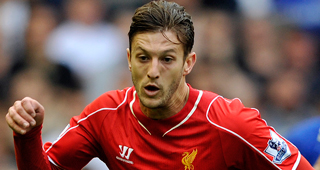Although he didn’t score or record an assist in Liverpool’s 3-1 win over Arsenal at the beginning of the month, Adam Lallana was his side’s most essential player in his own unique way. The tally of two tackles and one interception on the defensive end were also modest, but he was responsible for Liverpool’s fluid shape on that side of the ball. His decision making and timing of when to press Arsenal’s midfielders (particularly Francis Coquelin receiving the ball with his back turned) lead to immediate counter attacking opportunities. His display in winning the transition phase personified what Jurgen Klopp mean when describing gegenpressing as his side’s best playmaker.
The 28-year-old was rewarded with a new four-year contract running at the end of February.
As with the Arsenal match, his importance to the side lies beyond humble goal scoring statistics. In addition to recognizing pressing triggers when defending, Klopp singled out his importance in deciding when to break the Liverpool’s line on the attack end to destabilize opponents. Lallana ran the most out of any player in England in the quick holiday turnaround against Manchester City and Sunderland. He was second to Firmino last season in counterpressing recoveries made.
All this for a player who worked his way up with Southampton starting from League One. One can draw many parallels between him and quick rising peers Theo Walcott and Alex Oxlade-Chamberlain. The latter pair were phenoms who left for Arsenal as teenagers. In contrast, it took four seasons as a professional before Lallana set foot on the Premier League stage. His big club move to Liverpool came when he was 26, having captained the Southampton side. One could still easily imagine Lallana at Southampton. Reaching his peak form at 28 years old shows how a career arc is as much luck as science.
Lallana’s skillset made him a misunderstood player as recently as last season. A player’s intangibles, past goal scoring rates, are where the subtleties lie. Even after his Arsenal performance, Paul Merson thought the midfielder was struggling. He’ll never bask in the a 20 goal season or dribble through five defenders. His work is in the hard yards, between the boxes, in making important, match winning decisions for his side - in this case, when to attack a vulnerable opponent. His art is in the triggers and decisive movements to break out of his side’s compact structure. His playmaking is defined as much by his off-ball movements when Liverpool are out of possession as much as what he does with the ball at his feet. These are actions difficult to quantify, and especially not celebrated on the front page.
There was a learning curve in his adjustment to Anfield. The over $30 million price tag for a then 26 year old in 2014, along with the publicly drawn out transfer from Southampton, did him no favors. There were comparisons to Andres Iniesta back then, but no one quite understood what that looked like. In the meantime, he was lumped with other failed transfers like teammate Rickie Lambert, Christian Benteke, and Mario Balotelli. Perhaps his biggest crime was that he couldn’t replace Luis Suarez. Instead, Lallana played a variety of roles as Rodgers experimented with formations ranging from a 4-3-3 to a three defender backline. No one was happy.
Rodgers was unable to fit the square peg. He was not defensive enough to be trusted at the base of midfield, nor possessed the playmaking of a traditional number 10. If we were to distill his genius into one sentence, it may be in how he curves his pressing runs to the blind side of an opponent receiving the ball, thereby easily displacing the player in question. To quote motivational posters, Lallana’s inspiration came from perspiration. It was only when he played with other positionless, versatile attackers in Firmino, Coutinho, and Sadio Mane, was he able to find a drifting role in linking the attack.
Then, Rodgers was replaced by Klopp at the start of 2015 season. A literary figure could point out that Liverpool and Lallana mirrored each other in those finals matches under the Northern Irish manager - there was obvious skill, but without direction. The role of a manager is perhaps the most underrated aspect of any player’s career. One would think that a genius is a genius regardless of who is at the helm. There’s no doubting that Lallana was molded by the German manager, and that Lallana is made for the contemporary moment. Last season’s Liverpool side showed signs of eager running, yet Klopp sought to turn this into a science by poaching fitness trainer Andreas Kornmayer from Bayern. The hug between manager and player in Klopp’s first match at Liverpool symbolizes the commitment from both pupil and mentor. The difference between now and then is the added nuances of what to do once the ball is recovered. Mane and Firmino’s direct pace and dribbling stretch the field for Lallana to find pockets of space for his little touches.
Lallana will be 32 when his contract runs out. One assumes he’ll have slowed by before then on this current trajectory of what’s required under Klopp. But Lallana did get a late start to his career. The German manager, who emphasizes the importance of player mentality, referenced his leadership in awarding the contract and in pushing players in the U-23 side to become like him. It is not only what he does, but what he symbolizes in the larger structure both on and off the field. It took three seasons at Anfield, but now we have a clear answer of who Adam Lallana is: a leader of pressing movements, a veteran leader in the locker room, and an example for future Liverpool midfielders.



